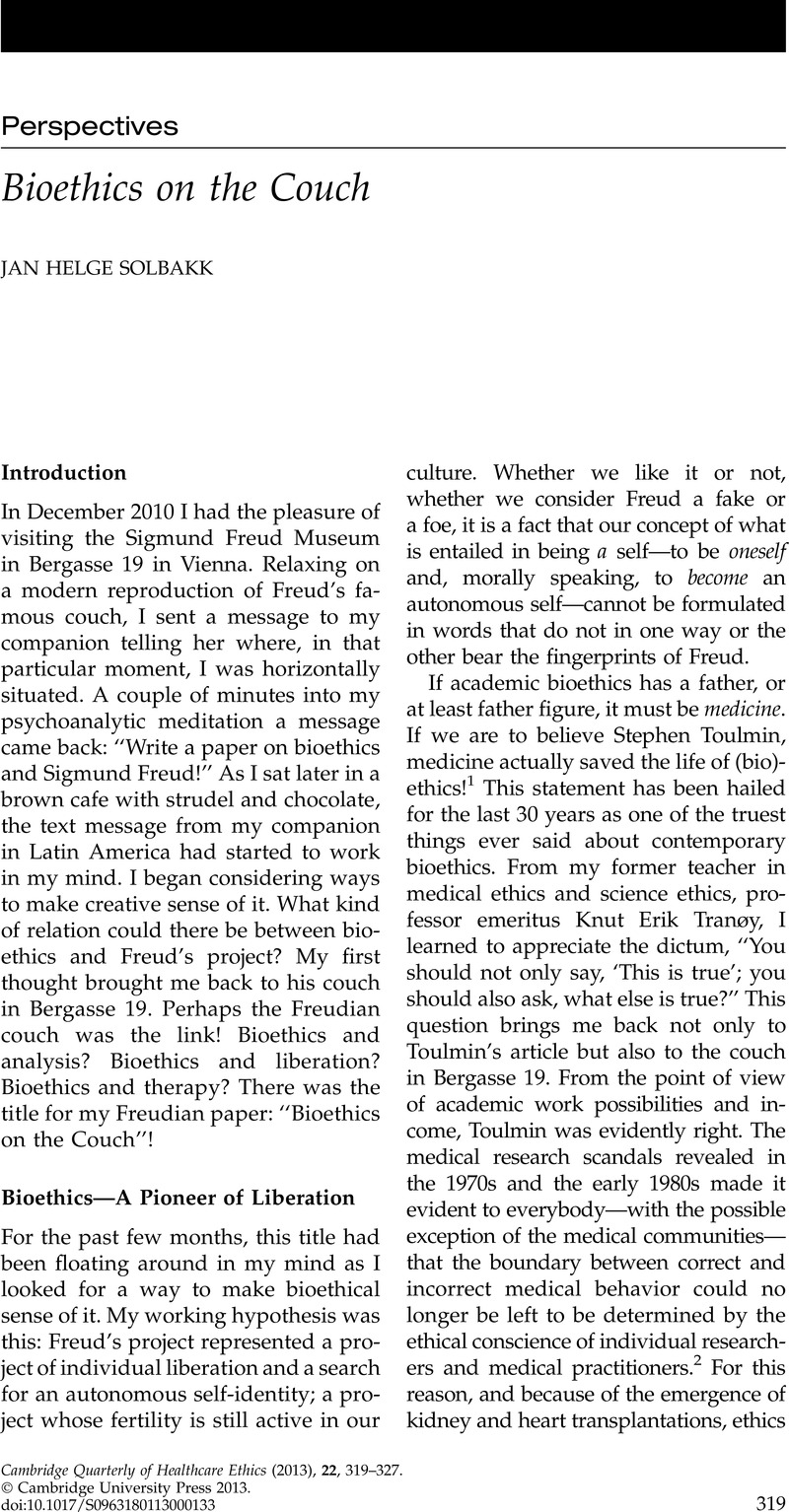Published online by Cambridge University Press: 30 April 2013

1 Toulmin, S.How medicine saved the life of ethics. Perspectives in Biology and Medicine 1982 Summer;25(4):736–50.Google Scholar
2 Solbakk, JH, Vidal, SM. Research ethics, clinical. In: Chadwick, R, ed. Encyclopedia of Applied Ethics. Second Edition, volume 3. San Diego: Academic Press; 2012. pp. 775–785.Google Scholar
3 Petersen, A.The Politics of Bioethics. New York: Routledge; 2011Google Scholar, at 2.
4 Ad Hoc Committee on Health Research Relating to Future Intervention Options. Investing in Health Research and Development. Geneva: World Health Organization; 1996.Google Scholar
5 Matsoso P, Auton M, Banoo S, Fomundam H., Leng H., Noazin S. How Does the Regulatory Framework Affect Incentives for Research and Development. Study Commissioned for the Commission on Intellectual Property Rights, Innovation and Public Health (CIPIH): World Health Organization; 2005; available at http://www.who.int/intellectualproperty/studies/Study5.pdf (last accessed 7 March 2013).
6 See note 2, Solbakk, Vidal 2012.
7 Ballantyne, A.How to do research fairly in an unjust world. American Journal of Bioethics 2010;10:26–35.Google Scholar
8 Solbakk, J.H.In the ruins of Babel: Pitfalls on the way towards a universal language for research ethics and benefit sharing. Cambridge Quarterly of Healthcare Ethics 2011;20:341–55.Google Scholar
9 Notable examples of bioethicists who have engaged themselves heavily in this endeavor include Schüklenk, U., Ashcroft, R.E.Affordable access to essential medication in developing countries: Conflicts between ethical and economic imperatives. Journal of Medicine and Philosophy 2002;27(2):179–95Google Scholar; Garrafa, V., Porto, D.Bioética, poder e injustiça: por uma ética de intervençao. In: Garrafa, V., Pessini, L., eds. Poder e Injustiça. CITY: Centro Universitário São Camilo, Edições Loyola and Sociedade Brasileira de bioética; 2003:35–44;Google ScholarBerlinguer, G.Bioethics, power and injustice. In: Garrafa, V., Pessini, L., eds. Poder e Injustiça. Brasilia: Centro Universitário São Camilo, Edições Loyola and Sociedade Brasileira de bioética; 2003:45–58;Google ScholarLondon, A.J.Justice and the human development approach to international research. Hastings Center Report 2005;35(1):24–37;Google ScholarVidal, S.M.Ethics or market, an urgent decision. Guidelines to design ethical norms in biomedical research in Latin America. In: Keyeux, G., Penchaszadeh, V., Saada, A., eds. Investigación en seres Humanos. Bogotá: UNESCO- Redbioetica UNESCO- UNIBIBLOS; 2006:191–232Google Scholar; available at http://www.unesco.org.uy/shs/es/areas-de-trabajo/ciencias-sociales/bioetica/documentos-publicaciones-en-bioetica.html (last accessed 7 March 2013); Garrafa, V., Lorenzo, C.Moral imperialism and multi-centric clinical trials in peripheral countries. Cadernos de Sáude Pública 2008;24(10):2219–26CrossRefGoogle ScholarPubMed; and London, A.L., Zollman, K.J.S.Research at the auction block: Problems for the fair benefits approach to international research. Hastings Center Report 2010;40(4):34–5.Google ScholarPubMed
10 Garrafa, V., Solbakk, J.H., Vidal, S.M., Lorenzo, C.Between the needy and the greedy: The quest for a just and fair ethics of clinical research. Journal of Medical Ethics 2010;36:500–4.Google Scholar
11 See note 8, Solbakk 2011.
12 See note 2, Solbakk, Vidal Forthcoming.
13 Sherwin, S.Whither bioethics? How feminism can help reorient bioethics. International Journal of Feminist Approaches to Bioethics 2008;1(1):1–27Google Scholar, at 19.
14 Bioethics at the bench. Nature 2006;440:1089–90, at 1890.
15 Petersen A. Whose profit? Why bioethics needs a global perspective. The Conversation 2011 Aug 22; available at http://theconversation.edu.au/whose-profit-why-bioethics-needs-a-global-perspective-1485 (last accessed 7 March 2013).
16 For a fascinating discussion of the metaphor of line drawing in bioethics, see Scully JL. Drawing a line: Situating moral boundaries in genetic medicine. Bioethics 2001;15(3):189–204.
17 See note 3, Petersen 2011.
18 See note 16, Scully 2001, at 204.
19 See note 16, Scully 2001, at 204.
20 Article 12, Respect for Cultural Diversity and Pluralism, reads, “The importance of cultural diversity and pluralism should be given due regard. However, such considerations are not to be invoked to infringe upon human dignity, human rights and fundamental freedoms, nor upon the principles set out in this Declaration, nor to limit their scope.” United Nations Educational, Scientific and Cultural Organization (UNESCO), Universal Declaration on Bioethics and Human Rights 2005. Available at: http://portal.unesco.org/shs/en/ev.php-URL_ID¼1883&URL_DO¼DO_TOPIC&URL_SECTION¼201.html
21 See note 3, Petersen 2011, at 6–7.
22 Kottow, M.H.Vulnerability: What kind of principle is it? Medicine, Health Care and Philosophy 2004;7:281–7.Google Scholar
23 Solbakk, J.H.Vulnerability: A futile or utile principle in health care ethics? In: Chadwick, R., ten Have, H., Meslin, E., eds. The Sage Handbook of Health Care Ethics: Core and Emerging Issues. Los Angeles: Sage; 2011:228–38.Google Scholar
24 See note 8, Solbakk 2011, at 345.
25 This notion, on which the fair benefit approach is based, originates from Alan Wertheimer, who makes a distinction between “harmful exploitation” and “mutually advantageous exploitation”: “By mutually advantageous exploitation, I refer to those cases in which both parties (the alleged exploiter and the alleged exploitee) reasonably expect to gain from the transaction as contrasted with the pretransaction status quo. . . . I shall generally presume that mutually advantageous transactions are also consensual.” Wertheimer, A.Exploitation on clinical research. In: Hawkins, S., Emanuel, E.J., eds. Exploitation and Developing Countries: The Ethics of Clinical Research. Princeton, NJ: Princeton University Press; 2008:63–104, at 67–68.Google Scholar
26 For this approach, see note 9, London 2005, and London, Zollman 2010.
27 Pogge, T.Intellectual property rights and access to essential medicines. Policy Innovations 2007Google Scholar; available at http://www.policyinnovations.org/ideas/policy_library/data/FP4 (last accessed 17 Nov 2010).
28 Dussel, E.Philosophy of Liberation. New York: Orbis Books; 1985.Google Scholar
29 See note 28, Dussel 1985, pp. 195–196 (emphasis mine).